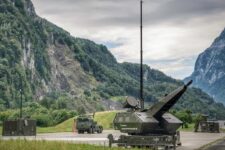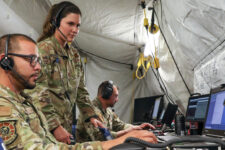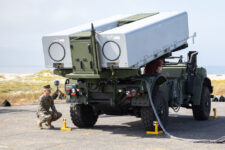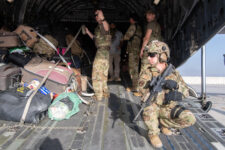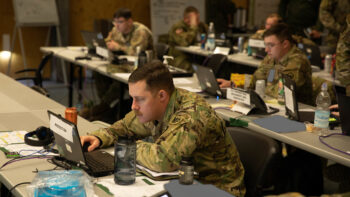
U.S. Army Spc. Delilah Crenshaw, a strategic communications specialist assigned to 2nd Multi-Domain Effects Battalion, 2nd Multi-Domain Task Force, ensures cables are securely connected to a GATR inflatable satellite antenna at an Arcane Thunder 23 training site in northwest Poland, Aug. 30, 2023. (U.S. Army photo by Staff Sgt. Ashley M. Morris)
WASHINGTON — In the desert outside of Agadir, American and Moroccan troops are putting new electronic warfare technology and tactics to the test. It’s a small but vital piece of a long-overdue effort to restore and update capabilities disbanded after the Cold War.
With a combination of high-tech, high-altitude balloons, and three very different types of drones, a battalion of the US Army’s 2nd Multi-Domain Task Force is practicing how to hunt for enemy radars and radio transmitters, triangulate their precise locations, and then shut them down. That might mean temporarily, using the battalion’s own drone-borne jammers, or permanently, using lethal drones — or by passing the coordinates to the MDTF’s in-house artillery, whose first long-range missile launchers are just entering service.
That’s the “core function” of the blandly named Multi-Domain Effects Battalion, said the unit’s commander, Lt. Col. Aaron Ritzema: “We ‘find and fix’ any potential target that we then pass on for further effects,” he told the NDIA Emerging Technologies conference via a live video feed from Morocco.
In essence, he said, it’s the same job that scouts and light cavalry have done for army commanders since ancient times — but with radically updated tools. Instead of only searching for the foe on land, he said, the battalion performs “multi-domain reconnaissance” that combines everything from aerial drones to cybersecurity software to satellite feeds.
The ongoing binational exercise, Arcane Thunder, is just the second such wargame for the three-year-old 2nd MDTF. Arcane Thunder 24 is already much more ambitious than the unit’s inaugural field exercise last year, which was held in Central Europe. In 2023, the Germany-based battalion could drive from its Wiesbaden barracks to exercise sites in Poland, Ritzema recounted, whereas getting to Morocco required coordinating the movement of people, equipment, and supplies by sea and air. Last time, Polish participation in the exercise was very limited, but this year, he said, “the Moroccans are fully integrated.”
“It’s a major opportunity to strengthen cooperation,” said Major Mouad Zerrik, a Moroccan signal officer with 20 years’ experience in the Royal Armed Forces. The Moroccans’ involvement began with early planning and concepts of operation, moved to classroom training in electronic and cyber warfare, and now has them in the field alongside Americans working with drones and portable EW equipment.
Because the entire exercise is limited to unclassified information — the scenario being simulated was actually developed for an earlier Moroccan wargame — the two countries are even able to share data nigh-instantly on a common network, Ritzema said. Specifically, they’re using the publicly available WinTAK software, a civilian Windows version of the famed Android Tactical Assault Kit. (Scaling up such near-instantaneous sharing of battlefield information to allies worldwide is one key piece — the “combined” — in the Pentagon’s broader Combined Joint All-Domain Command and Control.)
Such real-time coordination is important because the technology and tactics involved have also grown much more complex since the previous Arcane Thunder in Poland. In 2023, the battalion deployed three “tethered aerostats” — basically, blimps moored to a fixed site on the ground, like 21st century versions of a Civil War observation balloon — whose long-range, wide-area scans for suspect signals then cued follow-up flights by drones to narrow down the target coordinates.
This time, the battalion is using the aerostats again, Ritzema said, plus a small zoo of different drones, and even a pair of Triton unmanned surface vessels on loan from the Navy’s nine-month-old Task Force 66.
Ritzema said the Morocco exercise will involve two types of drones optimized for long surveillance flights. The Kraus Hamadi Aerospace K-1000 is a 40-pound mini-plane that can stay aloft for days on solar power [PDF]. Complementing it is the Shield AI V-BAT, which weighs more (125 lbs) and has a shorter flight time (about 10 hours) but has the advantage of taking off and landing vertically like a helicopter, without needing a runway or catapult launcher.
There are also two products of the Army’s Launched Effects initiative that Ritzema called “Spirit” and “Disruptor.” Not many details about those systems are available, but a test in March of the “medium range” variant of Launched Effects used the ALTIUS 700, a roughly 65-lb drone with a two-hour fight time that can carry sensors, jammers, or an explosive warhead.
Those drones need to be able to fly a long time and a long way. For this exercise, the battalion headquarters is set up in Agadir, but drone launch-and-recovery teams are 30-plus miles away, and the simulated targets even farther. The battalion’s doctrine calls for it to detect targets over 300 miles (500 kilometers) away. At a minimum, two balloons are airborne at any given time, providing a binocular “persistent stare” that can triangulate the source of any transmission, but at peak there could be eight different assets in the air.
RELATED: Army ‘on the cusp of greatness’ with its critical EW programs
As troops experiment in the desert, however, the Army is still awaiting a few relevant tools like long-range, high-powered jammers. The service’s long-awaited drone-borne jamming system, Multi-Function Electronic Warfare (MFEW) Air won’t enter service until 2026, with an initial fielding of just four pods. On the ground, where Russia currently deployed a varied arsenal of truck-borne high-powered jammers, the US Army has accelerated fielding of low-power backpack systems but the long-range TLS-EAB won’t enter service until mid-2026. (Both MFEW-Air and TLS, short for Terrestrial Layer System, are Lockheed Martin products).
“The Army doesn’t have a lot of programs of record aligned to the capabilities that we need for [our mission],” Col. Ritzema acknowledged, without naming any specific systems. Much of the equipment the battalion is using is not from formal large-scale procurements but prototypes and experiments on offer from industry partners, funneled through the Army’s Combat Capabilities Development Command. It’s essential for the battalion, he said, to “see, test, get our hands on equipment, and then go back to the Army” with its recommendations.
“We’re validating the network architecture, we’re maturing our COP [Common Operating Picture] tools,” he said. “[We] provide feedback on how these different technologies and capabilities work and ultimately go back to the big Army to inform operational needs statements and programs of record.”







